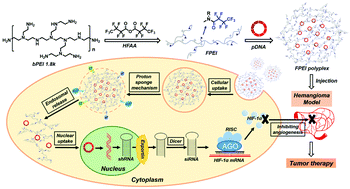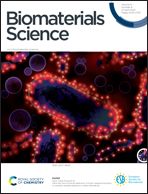A fluorinated low-molecular-weight PEI/HIF-1α shRNA polyplex system for hemangioma therapy†
Abstract
Hemangioma, one of the most common angiogenic diseases in infants and children, is characterized by the abnormal and aggressive proliferation of vascular endothelial cells. Advanced therapeutic strategies like RNA interference can inhibit the expression of target proteins at the translational level, but they are rarely used in hemangioma treatment owing to the lack of safe carriers. In this study, we showed for the first time that RNAi technology targeting HIF-1α (hypoxia-inducible factor-1 alpha) could benefit hemangioma therapy effectively. Heptafluorobutyric anhydride (HFAA) was used to modify low-molecular-weight PEI (PEI1.8k), and a novel fluorinated polycation carrier named fluorinated PEI (FPEI) was synthesized. Furthermore, HIF-1α-shRNA-pDNA was condensed by FPEI to fabricate FPEI polyplexes. Compared with PEI25k polyplexes, which are usually the gold standard used in gene delivery, FPEI polyplexes showed lower cytotoxicity and higher serum stability, transfection efficiency and gene silencing efficiency both in vitro and in vivo. In addition, we confirmed that FPEI polyplexes could efficiently inhibit the formation of new capillaries and tumor growth in vivo, which may provide a practicable strategy for clinical hemangioma treatment in the future.



 Please wait while we load your content...
Please wait while we load your content...